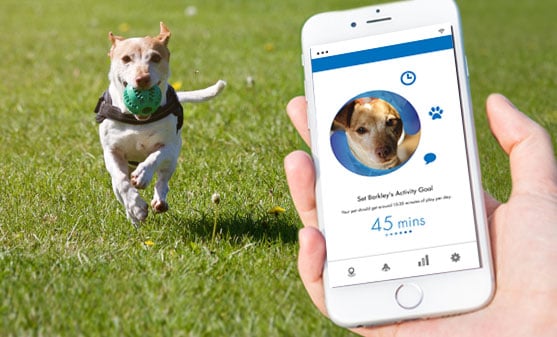What Do Pet Parents Want? Trends and the Wearable Pet Tech Market
Trends and the Wearable Pet Tech Market

Whether pets fill an empty nest or are the “first child” in a starter home, pets are part of the family that we just can’t help but spoil. And technology is becoming a preferred means for pampering.
In a 2018 survey with 2,000 adults, the Consumer Technology Association determined there are approximately 84.6 million pet-owning households in the U.S., the majority of which are those of Millennials and Baby Boomers. These pet owners consider their pets as their children, as they take their pets with them everywhere they go. In the process of humanizing them, they walk them in baby strollers, comfort them with television, send them to spas and throw them lavish birthday parties. These fur babies and four-legged children with a tail are no longer confined to the home when they happily tag along to mom or dad’s work, are dressed in matching holiday costumes and have custom-built furniture, not to mention that nearly half of their “parents” have purchased interactive toys for them.
As technology grows in importance in caring for pets, marketers need to better understand who is buying it and why.
Pet Tech Purchasing Power
It’s not really a contest of who loves their pet more, but perhaps who can afford to spend the most on their pet. Pawsible Marketing’s Top Pet Industry Trends for 2018 explored how different generations invest in their pets, with specific attention to the Millennial and Baby Boomer markets.
In the Millennial market, which accounts for 35 percent of the pet-owning population, these pet parents are social media darlings and online shoppers, and their need for instant gratification increases their willingness to spend. The caveat is they have limited financial resources and minimal brand loyalty. However, their lifetime of technological savviness gives them an edge in understanding and embracing the next generation of pet products, many of which come from and rely on technology. This makes Millennials the target pet tech consumer, particularly as the market moves forward.
In many ways, Baby Boomers are traditionalists when it comes to pet rearing. This generation, which is currently the “primary pet product and service purchaser,” represents 32 percent of the pet-owning population. They prefer to sample the goods and do business face-to-face. Currently the wealthiest generation, their pet is likely a grandpuppy or grandkitten, and they have the financial power to devote to them. That said, Baby Boomers are slower to embrace technology and see less of a need for it.
Top Trends – Caregiving Through Technology
Whether it’s Baby Boomers, GenZ or every generation in between, these populations genuinely love their pets. As we enter 2019, the top pet trends reflect just how much we adore our pets and treat them like members of the family.
Through modern veterinary medicine, pets are living longer, healthier lives. Therefore, consumers are purchasing products, tools and services to monitor and deliver a better quality of life to their pets. This includes geriatric and hospice pet care; home food delivery programs; treats and supplements; preventative medications for diabetes, cancer and joint problems; and both wearable and non-wearable pet technology, more commonly known as “pet tech.” This also includes the ability for consumers to participate in the veterinary and self-care of pets through apps and wearable technology.
Are we mirroring ourselves in our pets?
With apps, microchips, activity trackers, monitoring cameras and electric fences, we have constructed a digital environment for our pets much like we have created for ourselves. We are concerned about our health, safety and well-being, and we are willing to invest in technology that can calculate, digitize and monitor some, if not all of that for us. If we can do it for ourselves, why not do it for our pets?
Here lies the roadblock. Pet consumer research indicates that safety and security are the top problems that pet owners hope technology will solve. The APPA 2017-18 National Pet Owners Survey estimates that 43 percent of dog owners and 27 percent of cat owners already use electronic tracking devices on their pet. However, movement and fitness trackers, pet GPS, and training, calming and electric fence collars are just a sample of other more advanced wearable technologies that are available but come at a higher cost. The greatest barriers of adoption to pet tech are expense, followed by perceived lack of need and ease of use.
Marketers must first ascertain the importance of a pet’s safety, security and well-being, and then follow up with recognizing the necessity and accessibility of wearable pet tech. In the pet tech space, these are the key points and the most straightforward ways to approach consumers to this market. The long-term investment in a pet’s life is worth a short-term investment in cost to protect a pet and keep him or her safe, secure, and healthy.
Sources:
Pet Technology: Ownership, Use and Perceptions, April 2018, Consumer Technology Association
Top Pet Industry Trends for 2018, Pawsible Marketing
2017-18 National Pet Owners Survey, APPA
Check out other pet care content from R+K:
R+K launches inaugural pet panel
9 out of 10 veterinarians or 3 out of 5 stars
Standing out in the crowd: distinction in the pet supplements market
Dogs and driving don’t mix, unless the pets are safely confined
7 things your grandparents would have never done for their pets
For more information about our approach to marketing in the pet care industry, download our R+K Pet Care Credentials or contact our Business Development Director.

